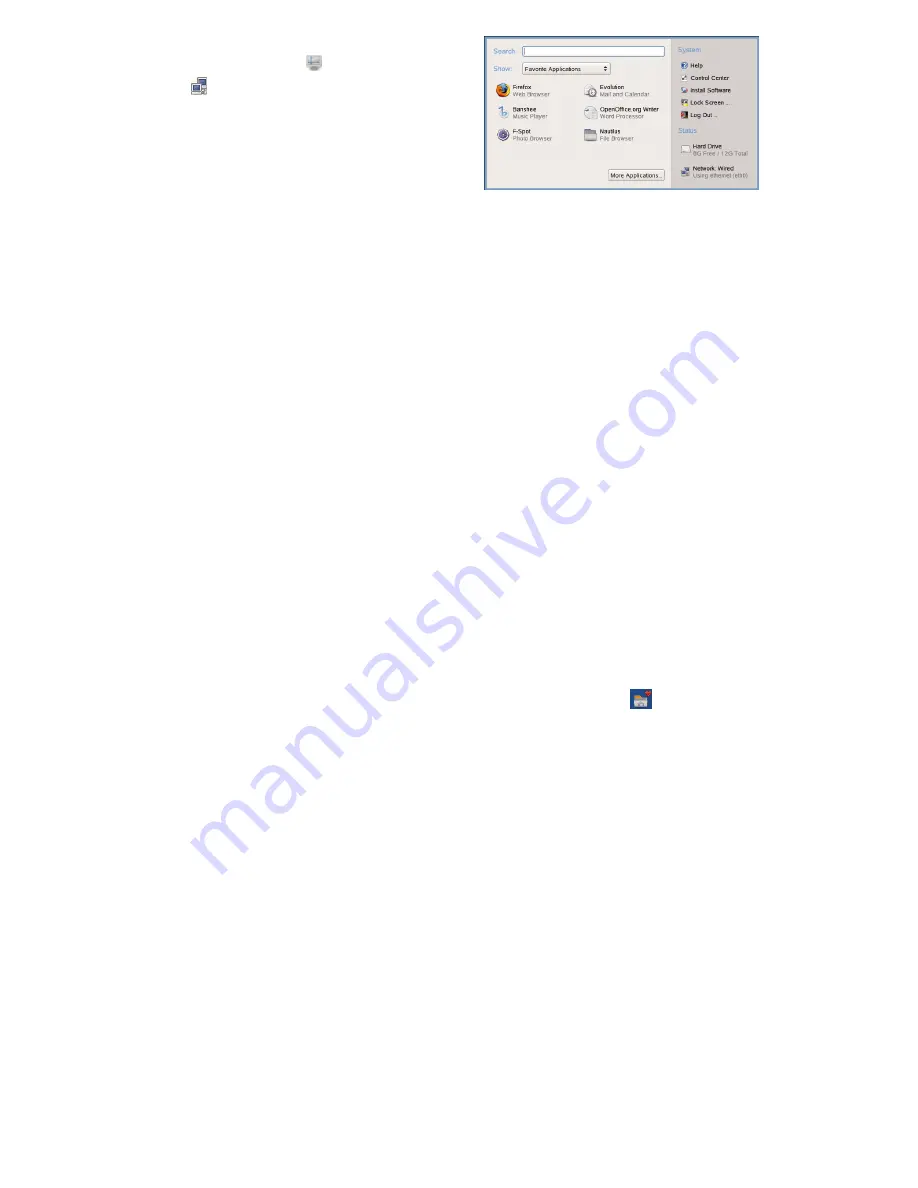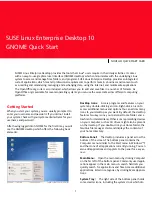
plays the date and time, the volume control, and icons for
several other helper applications. Click
to change your
screen resolution and
to display your network connec-
tions and options for disconnecting or changing network
configurations. This icon changes depending on the type
of network connection you have.
Taskbar:
By default, all started applications are displayed
in the taskbar (the area in the middle of the panel between
the Computer button and the system tray). You can access
any started application regardless of the currently active
desktop. Click an application name to open it. Right-click
an application name to see options for moving, restoring,
or minimizing the window.
Desktop Menu:
Right-clicking an empty spot on the
desktop displays a menu with various options. Click Create
Folder to create a new folder. Create a launcher icon for
an application with Create Launcher. Provide the name of
the application and the command for starting it, then select
an icon to represent it. You can also change the desktop
background and align desktop icons.
Desktop Panels
The bottom panel can be customized to meet your individ-
ual needs, and additional panels can be configured to fur-
ther personalize your desktop.
To add a new panel, right-click the bottom panel and select
New Panel. To delete a panel, right-click the panel and select
Delete This Panel. SLED requires that at least one panel be
left on the desktop.
Adding and Removing Panel Icons
1.
Right-click a blank space on the panel and select Add
to Panel.
2.
Browse to the desired program and double-click it to
add it to the panel.
3.
Customize the program icon as desired by right-clicking
the icon and selecting Preferences.
4.
To remove a program icon from a panel, right-click the
icon and select Remove From Panel.
Starting Programs
To run a program in SUSE Linux Enterprise Desktop, click
Computer on the panel to open the main menu screen. If
the program you want is not in the main menu screen, click
More Applications to view a list of all available applications.
You can also press
Alt
+
F1
to open a more traditional ver-
sion of the main menu. Navigate the submenus and click
an entry to start the corresponding program.
If you already know the name of an application but are not
sure how to start it from the main menu, use the Search
field in the main menu. Click Computer, type a part of the
application name in the Search field, then press
Enter
. If
the application is installed on your system, the name of the
application will appear in the Desktop Search dialog box.
Click the name to start the program.
Customizing Your Desktop
You can easily add, delete, and create shortcut icons on
your desktop. You can also change icon properties and the
desktop background to suit your needs.
Adding Program Icons to Your Desktop
1.
Click Computer.
2.
Browse to the desired program.
3.
Click and drag the icon to the desktop and position it
as desired.
To delete an icon from your desktop, simply click the pro-
gram icon and press the
Delete
key on your keyboard.
Changing Icon Properties
After a shortcut icon is on the desktop, you can change the
icon, add an emblem
(a graphic image placed on the
corner of the icon), configure permissions, or add a note
regarding the program. This is done through the Properties
dialog box. To access Properties:
1.
Right-click the icon and select Properties.
2.
From the tabs at the top of the dialog box, customize
the icon as needed. Some options include:
•
Basic:
Choose the Select Custom Icon option to
customize the look of the icon.
•
Emblems:
Choose a graphic image you want as-
sociated with the icon.
•
Permissions:
Assign permissions for the owner,
a group, or others who might be sharing this ma-
chine.
•
Notes:
Add notes regarding the program or its
use to the icon.
3.
Click Close when you have completed your changes.
2








